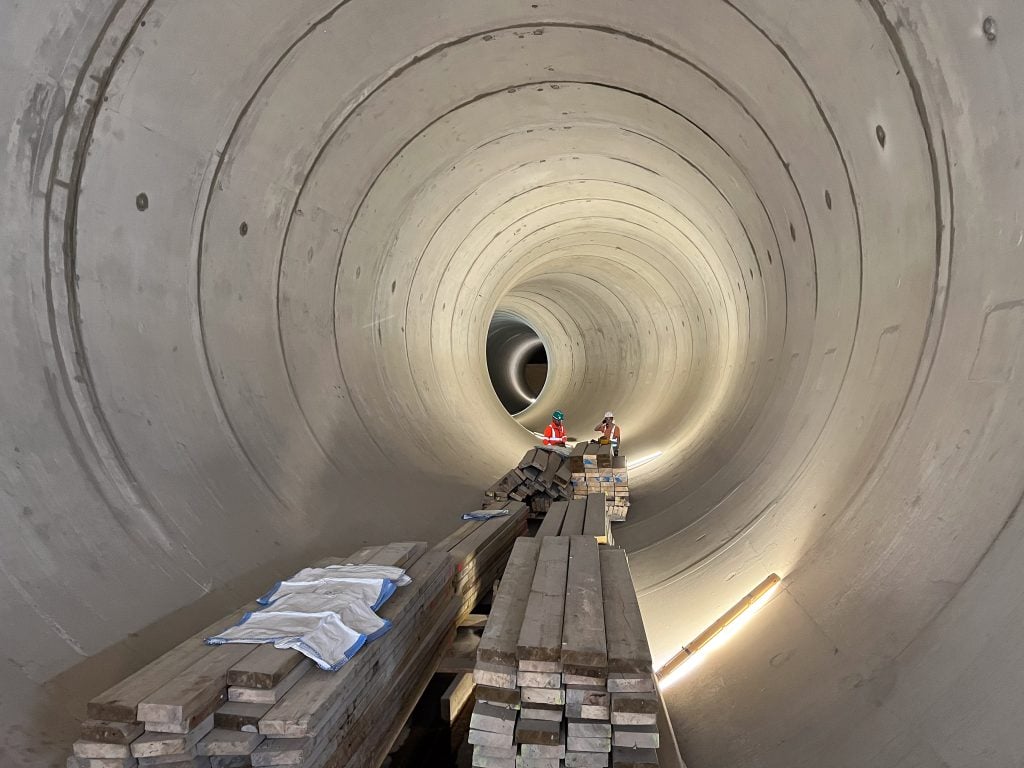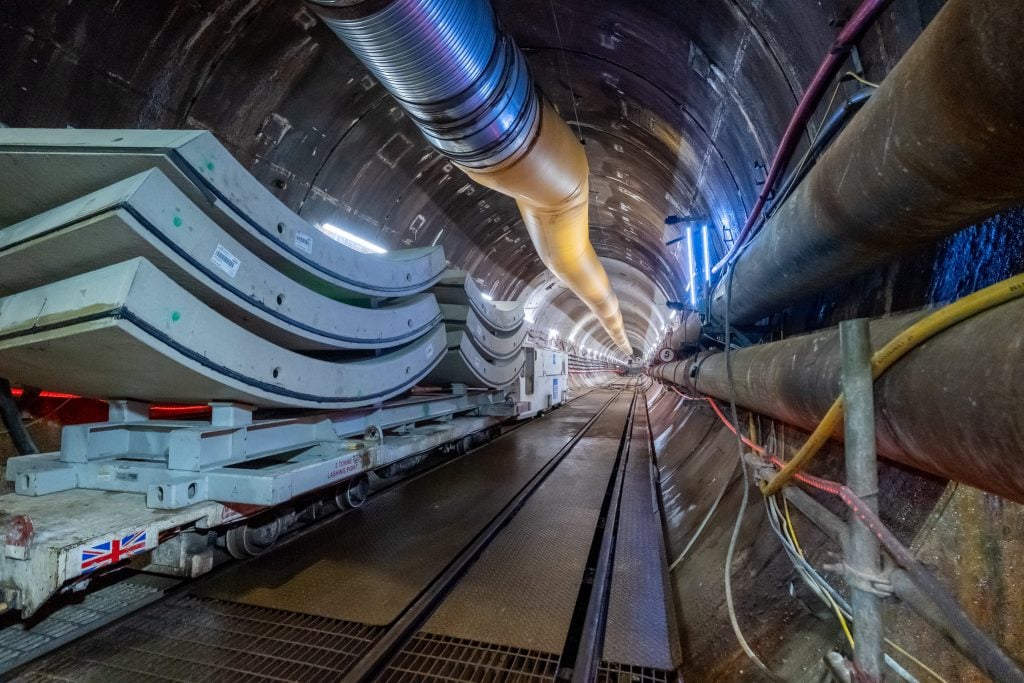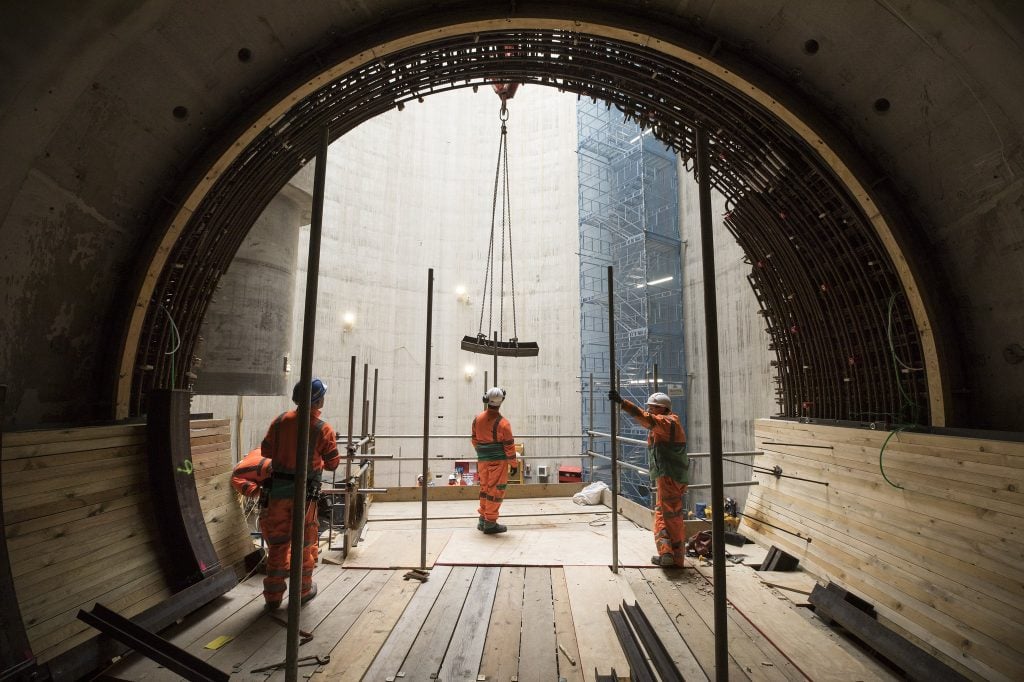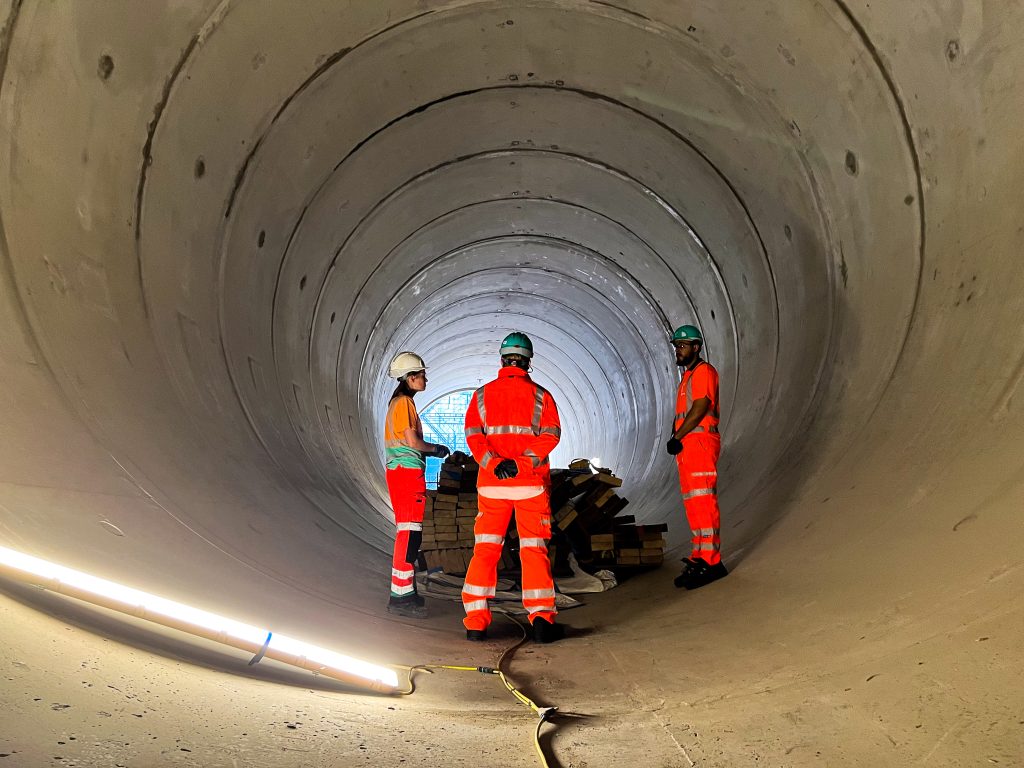London’s population is edging towards ten million, but its current sewage system dates back to the mid-19th century. That is until a new super sewer, known as the Tideway Tunnel and snaking 16 miles underneath the famous River Thames, opens next year. Before it does, we went for a look around.

Behind a turquoise wall in a quiet corner of west London, the ground opens up. Even after moving through the site’s reception, changing into protective gear, going through safety procedures and exchanging identification for a gas mask, the hole in the city’s surface seemingly comes out of nowhere. In the shadow of apartment buildings and on the shore of the Thames, the size and depth of the crater is staggering.
‘Shaft’ is the technical term for what I can only describe as a giant hole in the ground. It plummets down some 130 feet, the bottom only partially visible as I peer over the edge, already dizzy in gloves and a helmet on a sweltering day in the British capital. Though now one of 24 major locations spread along the Tideway Tunnel route, the site in Fulham, known as Carnwath Road Riverside, was one of the three ‘Main Drive Sites’: the original three shafts from which drilling on the super sewer began.
As of April 2022, after the best part of six years, the digging portion of Tideway is complete. It’s not all been plain sailing (disruption caused by the Covid-19 pandemic in the middle of the project surely the biggest hurdle), and the tunnel is not finished yet, but the work of Tideway’s six ‘tunnel boring machines’ is over. The custom-built, gargantuan drills are factories on wheels, and were used to burrow a path underneath one of the world’s busiest cities, navigating not only a winding river, but also London’s existing, subterranean world of train lines, gas pipes, water pipes and building foundations.
The challenge Tideway took on was, effectively, to build a second, smaller river underneath the Thames.

From the shaft at Carnwath Road, there are two ways down. Option one involves being lowered in a floating box by a crane. Option two, which sounds less vertigo-inducing, is taking stairs. The issue with these stairs, it turns out, is that they’re not the most sturdy. With each step comes a creak and a wobble; with every turn comes a perilous look at how much further you still need to descend.
I divert my eyes away from my feet for the first time about halfway through the descent. A smaller sewer, breaking off from the shaft, running across the river rather than parallel to it, becomes clear. It’s called the Frogmore Connection Tunnel (FCT) and is one of the major connection tunnels along the Tideway, linking the sewage overflows from a site in St George’s Park, with the main sewer coming into view below.
Below sea level, the beating sun is replaced by a light breeze. It smells of wet clay and is somehow reminiscent of a Bond villain’s lair. The endless concrete is interrupted only by neon-orange bodies moving seamlessly between stations, unphased by it all, nodding and then continuing on their way in executing some grand vision I can scarcely comprehend.
Were a villain to dwell down here, they would have a decent escape route. Despite knowing its diameter was almost 24 feet and expecting to be blown away by the size, it still comes as a surprise. As I stand there and admire this mammoth cylinder veering off into the abyss, it seems unfathomable that 16 miles of this thing could be filled with sewage and darkness. Yet it will be. In a way, it’s a shame. It’s rather beautiful in a dystopic sense, and this pristine feat of human engineering will be soiled by any and everything that Londoners flush down their toilets.

First, we walk east. In this direction the tunnel snakes sharply left and then right, the space lit up by beams on the floor. This portion of the tunnel has now been lined with two layers of concrete, which is “required to provide strength and to create a smooth surface over which flows will travel”. The result is a track fit for a car chase. More than 800 individual concrete pours were needed to line the tunnel between its origin in Acton and the Fulham site alone.
If you keep going east, as the liquid will when the tunnel is operational, the next location on the super sewer is called Falconbrook Pumping Station. Conveniently, the function of Falconbrook before and after the Tideway project is an example of precisely why the tunnel is being built.
Falconbrook Pumping Station currently releases more than 154,000,000 gallons of untreated sewage into the Thames each year. For sewage sites in London, this is the norm, rather than the exception. Falconbrook’s waste is only a drop in the ocean, considering an average of 8,580,000,000 gallons (over 50 times more than Falconbrook’s contributuon) are dumped in the river annually, the existing system forced to overflow almost every time it rains.
London’s sewers date all the way back to 1858. It was a particularly hot summer and the temperatures exacerbated the smell of the human waste and industrial sewage floating in the Thames, producing a smell still known as the “Great Stink”. The odor permeated the city, then the world’s most populous, even infiltrating the walls of the British parliament. Politicians tried to mask the smell by dousing the curtains of the House of Commons with chloride of lime, but it was futile. They rushed through a bill in just 18 days, funding the construction of a massive sewer system for London.

Under the stewardship of engineer Joseph Bazalgette, London’s original super sewer was constructed over the ensuing years, with the work finished by 1875. Designed to cater for up to four and half million people, 150 years on it is now forced to deal with a population twice as large, sharing the same pipes that carry London’s famous rainwater. With even a little rain, the system overflows, raw sewage being pumped into the Thames, as well as other English rivers and even coastal areas.
“Our job is to build a sewer that will address that,” Andy Mitchell, Tideway’s CEO said. The mission is to “intercept, store and ultimately transfer sewage waste away from the River Thames”. In the case of Falconbrook Pumping Station alone, the new tunnel will reduce the amount of sewage entering the river by 94%.
The video below better illustrates how exactly this will happen.
Heading west from the shaft at Carnwath Road, the Tideway Tunnel runs straighter, gently turning right with the river as it moves towards the borough of Hammersmith. There is less infrastructure on this side, and as we walk down the tunnel, the fading daylight and reflection from a small trail of water down the middle of the tunnel provide the only light. The sounds from work in the shaft fade into the distance and the acoustics make even having a conversation difficult; the volume ranges from very loud to very quiet depending seemingly on which way your head is turned. It’s impossible to notice, but walking in this direction you are walking up an ever-so-slight incline. The tunnel is designed to flow from west to east assisted solely by gravity, the westernmost point starting at 82 feet deep and plunging down to 215 feet at its lowest point.

Escaping the shaft, the crane seems preferable to climbing the stairs. As we wait for the lift to make its away down, there is a small figurine of Saint Barbara – the patron saint of tunnelers – sitting on the Tideway wall. Under her watchful eye, the lift takes me back to sunlight and Carnwath Road.
In even a few months’ time, this site will look transformatively different. Legacy, sustainability and the environment are at the core of the Tideway Tunnel project, including what will happen to the shaft locations after work is complete. In their own words, “every decision we made had the potential to make positive ‘ripples’”.
The super sewer vows to “protect the river for at least the next 100 years” and while planners hope it will last longer, the tunnel comes with a century guarantee. By this time, London’s population is estimated to be close to 15 million, and even though the new super sewer will occasionally overflow, it is built to operate at up to almost complete capacity before doing so.
The lifespan is perhaps the biggest commitment, but is one of 50 in total. “We’re creating new public spaces in the Thames – the first new land in London for generations,” Tideway said. “We’re raising the bar for health, safety and wellbeing in the construction industry; and we are using the river to transport material on an unprecedented scale, bringing jobs and skills back to the river.”
One of the most tangible benefits Londoners may experience is in sites themselves. Currently invisible and behind closed doors, each has a legacy plan for redevelopment once the super sewer is complete. Much like Bazalgette’s plans for creating the Thames Embankment in the 19th century, a series of parks, embankments and open spaces will follow the completion of Tideway.

In a speech reflecting on the progress made in 2022, Mitchell said: “I guess the thing that’s struck me most, is how much the sites are changing. Coming to completion, all those drawings and images are starting to materialize.” Mithcell placed the project as being 86% complete.
Given the overhaul Tideway is set to have and the size of the civil engineering project it has involved, it’s surprising that not more is being made of it.
The reasons vary. Politically, it could have hardly picked a more tumultuous time through which to avoid headlines. Underground, behind innocuous walls, it’s been out of public sight and largely out of public mind. Its cost, expected to be between £4 and £5 billion come completion, is dwarfed by the over £100bn being spent on HS2, England’s new proposed high-speed rail.
All the while, this remarkable project has been able to plow on unfettered. Whether or not its apparent success is a product of remaining out of the public eye, or it staying out of the public eye is a result of its apparent success, is an interesting hypothetical, more broadly relating to the British press’ sadist tendencies. Regardless, it would appear that in the Tideway Tunnel there is a monumental undertaking that is happening almost on-schedule, almost on-budget, and with a genuine consideration of its lasting effect.
Shame it’s all going to go to s**t next year.





